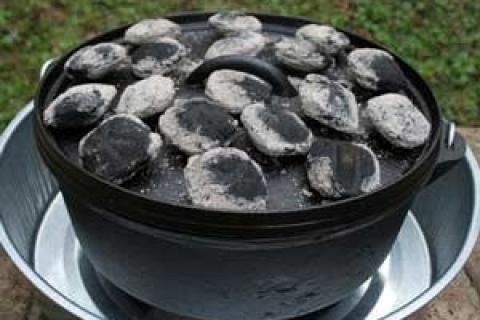
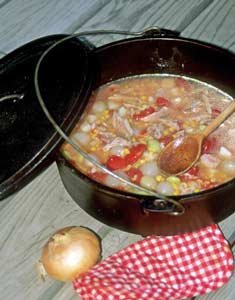 I learned Dutch oven cooking from a Scoutmaster named Gene Reddick. Gene had a magical way with one of these versatile utensils, baking some of the most delicious cobblers, cakes and pies I've ever tasted, with only the coals from a campfire for heat. During the five years I worked as a district executive with the Boy Scouts, Gene taught me the ins and outs of properly cooking Dutch oven dishes, and I'm proud to say that most of what he taught me sunk in. I can still whip up a batch of Dutch oven biscuits that are lip-smacking good.
I learned Dutch oven cooking from a Scoutmaster named Gene Reddick. Gene had a magical way with one of these versatile utensils, baking some of the most delicious cobblers, cakes and pies I've ever tasted, with only the coals from a campfire for heat. During the five years I worked as a district executive with the Boy Scouts, Gene taught me the ins and outs of properly cooking Dutch oven dishes, and I'm proud to say that most of what he taught me sunk in. I can still whip up a batch of Dutch oven biscuits that are lip-smacking good.
Dutch ovens as we know them today were developed in the early eighteenth century. They sometimes were called "bake kettles" or "bake ovens," but "Dutch oven" (a name of uncertain origins) became the title of choice long ago. By the mid-1700s, almost all American families were cooking in Dutch ovens on home hearths and campfires.
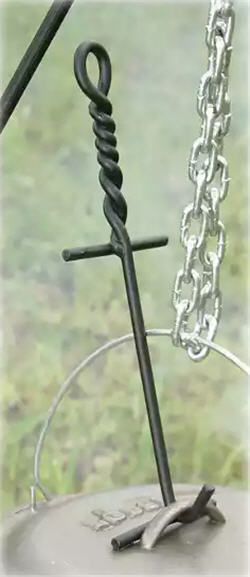
Camp Dutch Oven Lid
Lifter
The Dutch ovens used by today's camp cooks differ little from early models. Each is a large deep pot with a tightly fitting lid. Three short legs support the whole affair over coals on the ground (or on the hearth). The lid has a raised rim to retain coals that are placed on the lid and to keep ashes from falling into the oven when the lid is lifted. With this arrangement — coals on top and coals beneath -- the oven can be evenly heated for better cooking.
A fixed handle on top of the lid provides for lifting the lid. A bail of steel wire is permanently attached to the pot portion for lifting and moving the whole oven. (Early Dutch ovens often had a long handle instead of a bail.) Old-time ovens were heavy cast iron, as are many modern versions, but now you can get aluminum ones, too, that are lighter. I prefer, however, cast-iron ovens. Cast iron heats slowly and evenly, and retains the heat long after the pot leaves the fire. In aluminum ovens, which do not have these characteristics, food often burns and sticks.
Also available are a variety of Dutch oven accessories, including lid lifters, lid stands, gloves, tripods, tote bags and even Dutch oven cooking tables with windscreens. A variety of books describing Dutch oven cooking methods and recipes can be purchased as well.

with Tall Windscreen
Seasoning a cast-iron Dutch oven is very important. This is done by first cleaning the oven in hot water to remove any factory coating on the metal. (Most oven manufacturers recommend against using soap when washing.) Then rub salt-free shortening or cooking oil on all surfaces of the oven, and heat it for an hour or two with low heat. (Beef suet, bacon grease or salt-free butter or margarine can be used in a pinch.) This can be done in your home oven or with campfire coals. The ideal temperature is 250-300 degrees for two to three hours. After heating, remove the oven, allow it to cool and cover the whole metal surface with a light coating of shortening to protect the metal from rusting. Your oven will form a black patina, or finish, with continued use.
Aluminum ovens won't rust and don't need any preparation or treatment before or after use. Simply wash and dry; no need to oil.
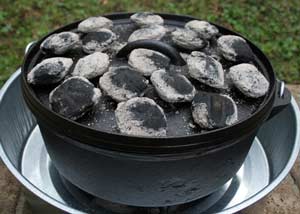
Preheat the oven before food is put in to bake. Do this by placing a few coals on top and a few underneath for several minutes. This helps keep food from sticking in the oven.
Food can be placed directly in the oven, or placed in a pan or aluminum foil wrapper in the oven. I like to cook large cuts of meat, soups and stews, and boiled or steamed vegetables, directly in the oven. Foil cups are good containers for muffins and breads. When making a cake or pie that needs to be removed for cutting and serving, I use a pan in the oven, elevated above the bottom to allow heated air to circulate all around and protect the dish from overheating by the coals beneath. A couple of metal tent pegs or nails, or a few pebbles, placed in the bottom of the oven support the pan.
Coals are placed under the oven, and on top, when cooking. Generally, when making dishes with large liquid content, such as stews and soups, you place two-thirds of the coals beneath and one-third on top. This transmits higher heat to the liquid in the oven and then on to your food. When baking, reverse these proportions: one-third beneath and two-thirds on top. Too many on the bottom may overcook the baking food. More coals on top give high heat to the baking air space in the oven and directly down to your food.
When using charcoal briquettes, I usually place six or seven under a 12-inch oven and 12-15 on top, replenishing these with new briquettes when preparing dishes with long cooking times. If the ground is damp, place a piece of aluminum foil on it to protect your coals or briquettes and get maximum heating.
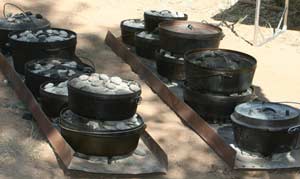
It's sometimes tricky maintaining the proper heat while cooking. Regulate it by adding or taking away coals on top or beneath, experimenting a bit if necessary. It's a good idea to build a small fire beside the oven and keep shoveling the fresh-made coals from there to the oven. Check the progress of your cooking by lifting the lid with tongs or a hook, and testing.
Remember, Dutch ovens are not just for baking. They work well for pan frying, broiling and deep-frying as well. The lid can be inverted and used as a griddle, with some rocks, or three metal tent pegs driven in the ground, as supports.
Dutch ovens are naturals for one-pot meals, but if you want to get spoiled, try the luxury of a whole battery of ovens: one for meat, one for vegetables, others for bread, pie, cake, cobbler, you name it. This is real living!
Here are some recipes to try.
1. Dutch Oven Venison Casserole Recipe
4 pounds venison tenderloin or steak, cut in one-inch cubes
1/2 cup butter
2 medium onions, sliced
1 pound fresh mushrooms, stems removed
1/2 cup flour
1 cup dry red wine
2 (10.5-ounce) cans condensed onion soup
2 soup cans water
Salt, black pepper
In a Dutch oven, saute venison cubes in butter until brown on all sides. Add onions and mushrooms; saute until vegetables are wilted. Sprinkle with flour. Stir in wine, soup and water. Stir to blend. Cover and place on coals at edge of campfire. Add coals to the oven lid. Cook 45 minutes for tenderloin, 1-1/2 to 2 hours for steak. Season to taste with salt and pepper.
2. Dutch Oven Baked Apples Recipe
- Several apples
- Sugar
- Cinnamon
- Butter
Wash and core apples, preparing one or two per serving. Sprinkle sugar and cinnamon inside the hole, then add a pat of butter. Put apples in a greased pie pan and add some water. Place the pan in a preheated Dutch oven, elevated to prevent burning. Cover, add coals on top and beneath, and bake for about 30 minutes.
3. Dutch Oven Pineapple Upside-Down Cake Recipe
- 1 (18-ounce) package yellow cake mix
- Eggs, milk or other ingredients needed to prepare cake mix
- 3 tablespoons melted butter
- 1/2 cup brown sugar
- 1 (16-ounce) can sliced pineapple
Prepare the cake mix in a large bowl per package instructions. Preheat the Dutch oven. Into a 10-inch round cake pan, pour the melted butter then sprinkle on the sugar. Briefly place the pan in the oven to melt the sugar and create the glaze. Remove the pan and place pineapple slices over the glaze. Pour the cake batter over this until the pan is slightly less than full, and set the pan in the oven atop some pebbles or metal tent pins. Bake until a toothpick inserted in the cake comes out clean. Allow to cool 15 minutes then invert onto a plate.
4. Dutch Oven Melt in Your Mouth Biscuits Recipe
- 2 cups Bisquick baking mix
- 1 cup sour cream
- 1 stick (1/2 cup) melted margarine
Preheat the Dutch oven. Mix all ingredients until smooth. Spoon dough into foil muffin cups, three-fourths full. Bake approximately 15 minutes.
5. Easy Dutch Oven Cobbler Recipe
- 3/4 cup melted butter
- 1 cup sugar
- 1 cup flour
- 2/3 cup milk
- 1 large can sliced fruit
Pour butter into the Dutch oven. Combine sugar, flour and milk. Pour over butter. Add fruit. Bake until golden brown.
- 10995 views

